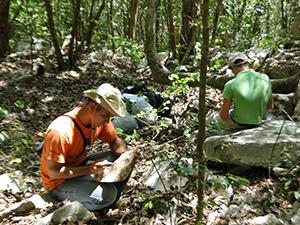René Alberto Barba Díaz
The project aims are to identify short-range endemic (SRE) arachnids from the tower karst of western Sierra de los Órganos, Pinar del Río, as well as to detect their threats in the protected area Sierra Pesquero-Mesa-Sumidero; meantime we intend to ensure their knowledge and conservation through an environmental education program, adequate measures for the future management plan and the establishment of Cuban tower karst's SRE network.

Collecting under stones in Francisco range.
Tower karst (mogotes) are markedly dependent from hydrological cycle and climatic variables. Despite their difficult access they have been affected by human activities (wood extraction, hunt, mining, agriculture, livestock, tourism and cave damages. Sierra Pesquero-Mesa-Sumidero is the second biggest protected area of Sierra de los Órganos (SO) that covers 5 305, 22 hectares, however their fauna diversity knowledge is incipient and there is not a management plan, because legal approval is underway. The project will offer important information (taxonomical, distributional, life history) about the arachnids from mogotes and caves, with special focus in the endemic species restricted to these ecosystems (SREs), which will have priority in the future conservation plan and also will serve for future environmental impact assessments and biogeographic studies. The proposed intensive surveys methodology will be helpful in identifying SREs, applicable in other groups of invertebrates at SO tower karst. Data about threats that face at present these ecosystems will be offered, in order to ensure the preservation not only of arachnids but all the species inhabiting tower karst of the zone.

Pitfall trap site in Mogote La Jíquima.
The project will suggest conservation measures for the future management plan of the area and will establish an environmental education program involving two communities (Ceja de Francisco and Sumideros), to increase the information about the natural values of mogotes, emphasizing their conservation. The training of school teachers and key local people will guarantee the continuity after the project. Also is expected to stimulate the interchange among fauna researchers that work, want to work or have worked in SO tower karst to contribute to the SREs knowledge and their conservation. This project will be the basis of the work with SRE arachnids from the entire SO.
The outcomes of this project will be a list of the tower karst arachnids from the protected area, remarking SREs (including cave arachnids); a GPS-referenced database; some products to support the environmental education program like pamphlets, posters, photo exhibitions, a documentary and a didactic game for children. Also during this project will be designed a website directed to the knowledge and conservation of the SREs in the mogotes. A publication and presentations in events will be other contributions.